churchill
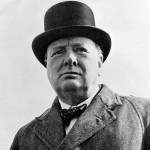
 While researching some of the larger battles of World War II, I began to consider the brilliance of the men who planned these battles. Men like Sir Winston Spencer-Churchill, Supreme Allied Commander General Dwight D Eisenhower, Admiral Chester Nimitz, Admiral Frank Fletcher, and Admiral Raymond Spruance (who was a replacement, but proved to be instrumental in the success of Midway). These men and others like them knew that the stakes were high, and by sheer numbers, the Allies were outnumbered by the Axis armies. That said, they also knew that the fate of the world was in their hands. If they lost this war, the Japanese and Germans would quite likely take over and rule the world. Life as we knew it would cease to exist.
While researching some of the larger battles of World War II, I began to consider the brilliance of the men who planned these battles. Men like Sir Winston Spencer-Churchill, Supreme Allied Commander General Dwight D Eisenhower, Admiral Chester Nimitz, Admiral Frank Fletcher, and Admiral Raymond Spruance (who was a replacement, but proved to be instrumental in the success of Midway). These men and others like them knew that the stakes were high, and by sheer numbers, the Allies were outnumbered by the Axis armies. That said, they also knew that the fate of the world was in their hands. If they lost this war, the Japanese and Germans would quite likely take over and rule the world. Life as we knew it would cease to exist.
Strategy is everything. Of course, part of that strategy involves something that many Americans have come to hate these days…fake news. These strategic minds knew that somehow they had to fool the Japanese into believing that no attack was coming, or that the advancing armies were headed elsewhere. It sounds simple, but this wasn’t the movies. Nevertheless, information was leaked to the enemy, while the Allied armies advanced as planned. The strategy worked perfectly on D-Day when Hitler was fooled, by men he had called idiots, into thinking that the target was at some point along their Atlantic Wall…the 1,500-mile system of coastal defenses that the German High Command had constructed from the Arctic Circle to Spain’s northern border…or even as far away as the Balkans. Vital to Operation Bodyguard’s success were more than a dozen German spies in Britain who had been discovered, arrested and flipped by British intelligence officers. The Allies  fed faulty information to these Nazi double agents to pass along to Berlin. A pair of double agents nicknamed Mutt and Jeff relayed detailed reports about the fictitious British Fourth Army that was gathering in Scotland with plans to join with the Soviet Union in an invasion of Norway. The Allies also fabricated radio chatter about cold-weather issues such as ski bindings and the operation of tank engines in subzero temperatures. The plan worked as Hitler sent one of his fighting divisions to Scandinavia just weeks before D-Day.
fed faulty information to these Nazi double agents to pass along to Berlin. A pair of double agents nicknamed Mutt and Jeff relayed detailed reports about the fictitious British Fourth Army that was gathering in Scotland with plans to join with the Soviet Union in an invasion of Norway. The Allies also fabricated radio chatter about cold-weather issues such as ski bindings and the operation of tank engines in subzero temperatures. The plan worked as Hitler sent one of his fighting divisions to Scandinavia just weeks before D-Day.
At Midway, the American “Doolittle” raid, a propaganda air attack on Tokyo launched from the carrier USS Hornet, prompted Japanese Admiral Isoroku Yamamoto to plan a final showdown with the remnants of the American fleet before letting his forces rest. The “Doolittle” raid had been an insult and it had threatened the life of the emperor. Yamamoto was confident that he had the advantage in numbers and quality to destroy the American carrier fleet. He planned to confuse the enemy with a diversionary attack on the Alaskan coast, drawing the Americans north, only to launch his main attack on Midway Island the following day, which would see the Americans hurrying south, into an ambush. With a great show of overelaboration, which was typical of Japanese military planning. Yamamoto divided his force into three main groups. There were four big carriers, the battlefleet, and the invasion force. These three groups were too far apart for mutual support. The Japanese carrier group operated in close order, commanded by Admiral Nagumo, who had led them for the attack at Pearl Harbor. Nimitz, for his part, could not hope to win a direct engagement. He had to stake everything on exploiting his intelligence windfall, and try to ambush the enemy. He secretly reinforced the air units on Midway, using the island as an unsinkable aircraft carrier. His sea-going carriers were positioned to the 
 northeast of the island, waiting to ambush the Japanese carriers when they arrived for their assault. The American tactics relied on the peculiar characteristics of carrier warfare. Nimitz knew the first attack would be decisive for either side, carriers being full of fuel and ordnance, hence highly vulnerable to bombs and torpedoes. The American tactical commanders, admirals Frank Fletcher and Raymond Spruance, also knew they were playing for very high stakes. They kept the two task forces separate. The strategy worked, and the Japanese never fully recovered.
northeast of the island, waiting to ambush the Japanese carriers when they arrived for their assault. The American tactics relied on the peculiar characteristics of carrier warfare. Nimitz knew the first attack would be decisive for either side, carriers being full of fuel and ordnance, hence highly vulnerable to bombs and torpedoes. The American tactical commanders, admirals Frank Fletcher and Raymond Spruance, also knew they were playing for very high stakes. They kept the two task forces separate. The strategy worked, and the Japanese never fully recovered.
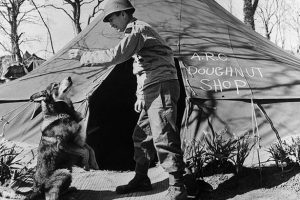
 During the United States led invasion of Sicily in July 1943, called Operation Husky, US Army dog, Chips and his platoon came under fire as they landed on a beach at dawn. Obviously, dogs made great sentries for the Army, and so were incorporated into the Army for that purpose. Chips was very good at his job and very loyal to his military masters. Fear never figured into Chips actions. If he saw that his platoon was under attack, Chips sprang into action. Chips charged an enemy machine gun to protect his people. His quick action was credited with saving his platoon. When the attack began, the soldiers scrambled to find cover, but Chips broke free from his lead and ran directly to the hut that housed the machine gun. Chips entered the hut, and immediately the shooting stopped. There was no barking or snarling, and no screaming, but momentarily, an enemy soldier appeared with Chips at his throat. Of course, that explained the silence. Neither the enemy soldier or Chips were able to speak or make any noise at that point, because they were otherwise occupied. I can only imagine the thoughts that were going through the enemy soldier’s mind. I would think there would be a large degree of praying for his life. At that point, I suspect the US Army platoon looked like angels sent to free the poor enemy soldier, and a prisoner of war camp might have looked like a relaxing vacation, compared to having his throat ripped out but a viscous German Shepherd dog. The quick and capable action displayed by Chip allowed the platoon to push on with their mission.
During the United States led invasion of Sicily in July 1943, called Operation Husky, US Army dog, Chips and his platoon came under fire as they landed on a beach at dawn. Obviously, dogs made great sentries for the Army, and so were incorporated into the Army for that purpose. Chips was very good at his job and very loyal to his military masters. Fear never figured into Chips actions. If he saw that his platoon was under attack, Chips sprang into action. Chips charged an enemy machine gun to protect his people. His quick action was credited with saving his platoon. When the attack began, the soldiers scrambled to find cover, but Chips broke free from his lead and ran directly to the hut that housed the machine gun. Chips entered the hut, and immediately the shooting stopped. There was no barking or snarling, and no screaming, but momentarily, an enemy soldier appeared with Chips at his throat. Of course, that explained the silence. Neither the enemy soldier or Chips were able to speak or make any noise at that point, because they were otherwise occupied. I can only imagine the thoughts that were going through the enemy soldier’s mind. I would think there would be a large degree of praying for his life. At that point, I suspect the US Army platoon looked like angels sent to free the poor enemy soldier, and a prisoner of war camp might have looked like a relaxing vacation, compared to having his throat ripped out but a viscous German Shepherd dog. The quick and capable action displayed by Chip allowed the platoon to push on with their mission.
Of course, Chips was simply doing his job, and likely thought nothing more of it. He loved these men, and putting his life on the line for them was just what he would do for those he loved. The men he saved, felt very differently about their hero, however. It’s hard not to feel like the being that put itself between you and certain death is very special. At the time, nothing was done to recognize the heroic act of Chips, but the men never forgot what their fellow soldier had done for them. My guess is that Chips got a pat on the head, and maybe a 
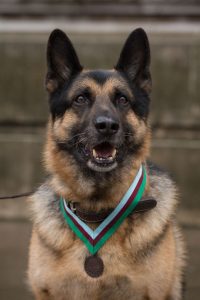 little extra food that night, but it was not enough for what he had done. How could it be?
little extra food that night, but it was not enough for what he had done. How could it be?
I guess the Army must have agreed, because Chips was posthumously awarded the PDSA Dickin Medal, which is recognized as the “Animal Victoria Cross,” 71 years after his passing, for protecting British troops. Chips was also a sentry at the Casablanca Conference in January 1943, where Churchill and Roosevelt met, so he had some experience in sentry duties before his famous act of protection. Chips continued on in his career until 1945. Then he was returned to his family in New York in 1945. Unfortunately, he died the next year…but Chips died a hero.

 In a war, sometimes the best thing that can be done is to retreat, but that is not always easy to do. When the enemy is closing in and there seems no way of escape. Sometimes, a way of escape seems to come together in such a way that it almost seems miraculous…or maybe that is the only real explanation…a miracle. Such seemed to be the case with Britain both in Dunkirk, France, called Operation Dynamo, and again from Cherbourg, Saint Malo, Brest, and Nantes, dubbed Operation Aerial. The evacuation from Dunkirk, was most likely the largest of its kind, or at least up to that date. I suppose there might have been others since then, but I am not aware of any. During the evacuation of Dunkirk, the British managed to evacuate 338,226 soldiers…and almost unheard of amount of men were saved, by a coordinated effort using 860 boats. During Operation Ariel, another 191,870 troops were rescued, bringing the total of military and civilian personnel returned to Britain during the Battle of France to 558,032, including 368,491 British troops.
In a war, sometimes the best thing that can be done is to retreat, but that is not always easy to do. When the enemy is closing in and there seems no way of escape. Sometimes, a way of escape seems to come together in such a way that it almost seems miraculous…or maybe that is the only real explanation…a miracle. Such seemed to be the case with Britain both in Dunkirk, France, called Operation Dynamo, and again from Cherbourg, Saint Malo, Brest, and Nantes, dubbed Operation Aerial. The evacuation from Dunkirk, was most likely the largest of its kind, or at least up to that date. I suppose there might have been others since then, but I am not aware of any. During the evacuation of Dunkirk, the British managed to evacuate 338,226 soldiers…and almost unheard of amount of men were saved, by a coordinated effort using 860 boats. During Operation Ariel, another 191,870 troops were rescued, bringing the total of military and civilian personnel returned to Britain during the Battle of France to 558,032, including 368,491 British troops.
Operation Aerial began on June 15, 1940 and ended on June 25, 1940. Following the military collapse in the Battle of France against Nazi Germany, it became evident that Allied soldiers and civilians were in grave danger. With two-thirds of France now occupied by German troops, those British and Allied troops that had not participated in Operation Dynamo, the evacuation of Dunkirk, were shipped home, but there remained a concern for the areas from Cherbourg, St. Malo, Brest, and Nantes. While these men were not under the immediate threat of assault, as at Dunkirk, they were by no means safe, so Brits, Poles, and Canadian troops were rescued from occupied territory by boats sent from Britain. Meanwhile, British Prime Minister Winston Churchill offered words of encouragement in a broadcast to the nation, “Whatever has happened in France…we shall defend our island home, and with the British Empire we shall fight on unconquerable until the curse of Hitler is lifted.” This was his way of promising that Britain would never fall under Nazi rule.
Operation Aerial was split into two sectors. Admiral James, based at Portsmouth, was to control the evacuation from Cherbourg and St Malo, while Admiral Dunbar-Nasmith, the commander-in-chief of the Western Approaches, based at Plymouth, would control the evacuation from Brest, St. Nazaire and La Pallice. Eventually this western evacuation would extend to include the ports on the Gironde estuary, Bayonne and St Jean-de-Luz. Once the people were on board, I’m sure they thought they were finally safe, but that was not necessarily the case. The Germans attacked the rescue boats. Among those rescued from the shores of France, were 5,000 soldiers and French civilians on board the ocean liner Lancastria, which had picked them up at St. Nazaire. Germans bombers sunk the liner on June 17, 1940, and 3,000 passengers drowned. Churchill ordered that news of the Lancastria not be broadcast in Britain, fearing the effect it would have on public morale, since everyone was already worried about a possible German invasion now that only a channel separated them. The British public would eventually find out, but not for another six weeks, when the news broke in the United States. They would also receive the good news that Hitler had no immediate plans for an invasion of the British isle, “being well aware of the difficulties involved in such an operation,” reported the German High Command.
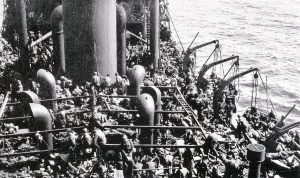

In the end, the evacuations dubbed Operation Dynamo and Operation Aerial, were successful, in that most of those who were evacuated made it home. I’m sure that the retreats did not feel like a success or a victory to the soldiers fighting in the Battle of France, but I am also sure that they were thankful to be among those who made it home. They would live to fight another day in the horrendous war that was World War II.
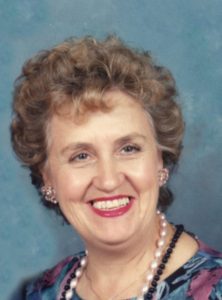
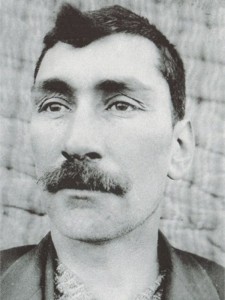 As I contemplated today’s story, I thought about one of my biggest fans…my mom, Collene Spencer, but I’m getting a little ahead of myself. I was researching a part of our family tree, after a conversation with a co-worker, Carrie Beauchamp, who had the opportunity, while living back east to visit one of the Vanderbilt mansions. I knew that my 2nd great uncle was named Cornealius Vanderbilt Spencer, but I didn’t know if there was any real connection, or rather maybe his mother just wished there had been a connection. So, I set out to look. I was pretty sure I had seen the Vanderbilt name somewhere else in my tree. My research brought me to Consuelo Vanderbilt, who married Charles Richard Spencer Churchill, who is my 15th cousin once removed.
As I contemplated today’s story, I thought about one of my biggest fans…my mom, Collene Spencer, but I’m getting a little ahead of myself. I was researching a part of our family tree, after a conversation with a co-worker, Carrie Beauchamp, who had the opportunity, while living back east to visit one of the Vanderbilt mansions. I knew that my 2nd great uncle was named Cornealius Vanderbilt Spencer, but I didn’t know if there was any real connection, or rather maybe his mother just wished there had been a connection. So, I set out to look. I was pretty sure I had seen the Vanderbilt name somewhere else in my tree. My research brought me to Consuelo Vanderbilt, who married Charles Richard Spencer Churchill, who is my 15th cousin once removed.
I knew that I was related to Winston Spencer Churchill, who is also my 15th cousin once removed, and I knew how his name had been changed from what should have been Spencer, when his 4th great grandfather, Charles Spencer married one Anne Churchill, in a merger that was mutually beneficial to both families, and changed the name to Spencer-Churchill. Through the years some of that branch of the family went on to stay 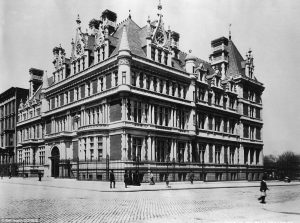 Spencer-Churchill, eventually dropping the hyphen, making the Spencer name appear to be a middle name. Others dropped the Churchill name, going back to Spencer, and still others dropped the Spencer name, deciding to stick with Churchill. Nevertheless, they are all my cousins at some level. In my search, I found where Consuelo Vanderbilt was indeed my 15th cousin once removed, and so my 2nd great grandparents, Allen and Lydia Spencer did have the actual connection to the Vanderbilt name, and were justified in naming their son Cornealius Vanderbilt Spencer. And since there was an actual Cornealius Vanderbilt, who built the Vanderbilt mansion in New York City, I guess the first name was after an ancestor too.
Spencer-Churchill, eventually dropping the hyphen, making the Spencer name appear to be a middle name. Others dropped the Churchill name, going back to Spencer, and still others dropped the Spencer name, deciding to stick with Churchill. Nevertheless, they are all my cousins at some level. In my search, I found where Consuelo Vanderbilt was indeed my 15th cousin once removed, and so my 2nd great grandparents, Allen and Lydia Spencer did have the actual connection to the Vanderbilt name, and were justified in naming their son Cornealius Vanderbilt Spencer. And since there was an actual Cornealius Vanderbilt, who built the Vanderbilt mansion in New York City, I guess the first name was after an ancestor too.
As I thought about that connection, my mind instinctively thought of how much my biggest fan…my mom would have loved that story. Of course, when those thoughts of my parents, and my desire to tell them something surface, my mind, in its ability to fool itself, thinks that I really can’t wait to tell my parents what I have found, or to have my mom read this story. She would have been so excited to hear that new information. It wasn’t that she ever wanted to be snobby, or even that she would have cared about being related to the Vanderbilt 
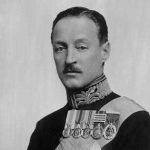 family, but rather that she would have found the information very interesting, and in fact, as amazing as I did, because it really is a small world, when you think about it. I’m sure there are many other famous, rich, or even infamous people that our family is related to, because there are so many branches that split off of the originals, that it’s bound to connect us to someone famous at some point. I just always find it rather surprising every time it happens, and I think my mom did too. I wish I could have told her about it…but then I suppose she already knows.
family, but rather that she would have found the information very interesting, and in fact, as amazing as I did, because it really is a small world, when you think about it. I’m sure there are many other famous, rich, or even infamous people that our family is related to, because there are so many branches that split off of the originals, that it’s bound to connect us to someone famous at some point. I just always find it rather surprising every time it happens, and I think my mom did too. I wish I could have told her about it…but then I suppose she already knows.
 The dukedom of Marlborough is one of the titles in the Peerage of England. The Peerage of England comprises all peerages created in the Kingdom of England before the Act of Union in 1707. In that year, the Peerages of England and Scotland were replaced by one Peerage of Great Britain. The peerage is a legal system of largely hereditary titles in the United Kingdom, which is constituted by the ranks of British nobility and is part of the British honors system. The dukedom of Marlborough was created by Queen Anne in 1702, for John Churchill, who was the 1st Duke of Marlborough.
The dukedom of Marlborough is one of the titles in the Peerage of England. The Peerage of England comprises all peerages created in the Kingdom of England before the Act of Union in 1707. In that year, the Peerages of England and Scotland were replaced by one Peerage of Great Britain. The peerage is a legal system of largely hereditary titles in the United Kingdom, which is constituted by the ranks of British nobility and is part of the British honors system. The dukedom of Marlborough was created by Queen Anne in 1702, for John Churchill, who was the 1st Duke of Marlborough.
I can’t say that I completely understand all there is to about the peerage of Great Britain, but in the peerage, a Duke is a higher rank than a Marquess, Earl, Viscount and Baron. Thus Prince William is the Duke of Cambridge, because as the prince, it would not be right for him to have a lower rank than other members of the peerage. Originally dukes were the rulers of the provinces of the Roman Empire. Now however, the title of duke has become in almost all cases a nominal rank, without possession of an actual principality. The province that a duke was titled over, is known as a duchy. As I said, in modern times dukes aren’t really over a duchy, with the exception of Lancaster and Cornwall, both of which do include land and ownership. Lancaster belongs to Queen Elizabeth II and Cornwall to Prince Charles. The title of duke cannot normally be handed down to female heirs, but the Dukedom of Marlborough is the exception to that rule. It is one of the few titles that allows females to inherit the title, and the only current dukedom to do so.
In the Spencer family, there have been a number of titles, but it wasn’t until Charles Spencer, 3rd Earl of Sunderland, widowed following the death of his first wife, Arabella, daughter of Henry Cavendish, 2nd Duke of  Newcastle, married Anne Churchill, that the Dukedom of Marlborough first came to the Spencers. With this dukedom, Charles Spencer was first introduced to politics, making this alliance between Sunderland and Marlborough a very important one for Charles and his descendants. From his marriage to Anne Churchill who would become the 2nd Duke of Marlborough, the Spencer family would retain the dukedom for all time. At the current time, the dukedom is at 12, with Charles James Spencer-Churchill, 12th Duke of Marlborough, born in 1955, as the current duke.
Newcastle, married Anne Churchill, that the Dukedom of Marlborough first came to the Spencers. With this dukedom, Charles Spencer was first introduced to politics, making this alliance between Sunderland and Marlborough a very important one for Charles and his descendants. From his marriage to Anne Churchill who would become the 2nd Duke of Marlborough, the Spencer family would retain the dukedom for all time. At the current time, the dukedom is at 12, with Charles James Spencer-Churchill, 12th Duke of Marlborough, born in 1955, as the current duke.
To date, I cannot say how many dukes and duchesses were or are Spencer descendants, for names change with marriages over the years. Nevertheless, the Spencers have played a great part in the peerage of Great Britain, and with Prince William and his descendants, beginning with Prince George, the Spencers will continue to have great influence in that nation for the rest of time.

